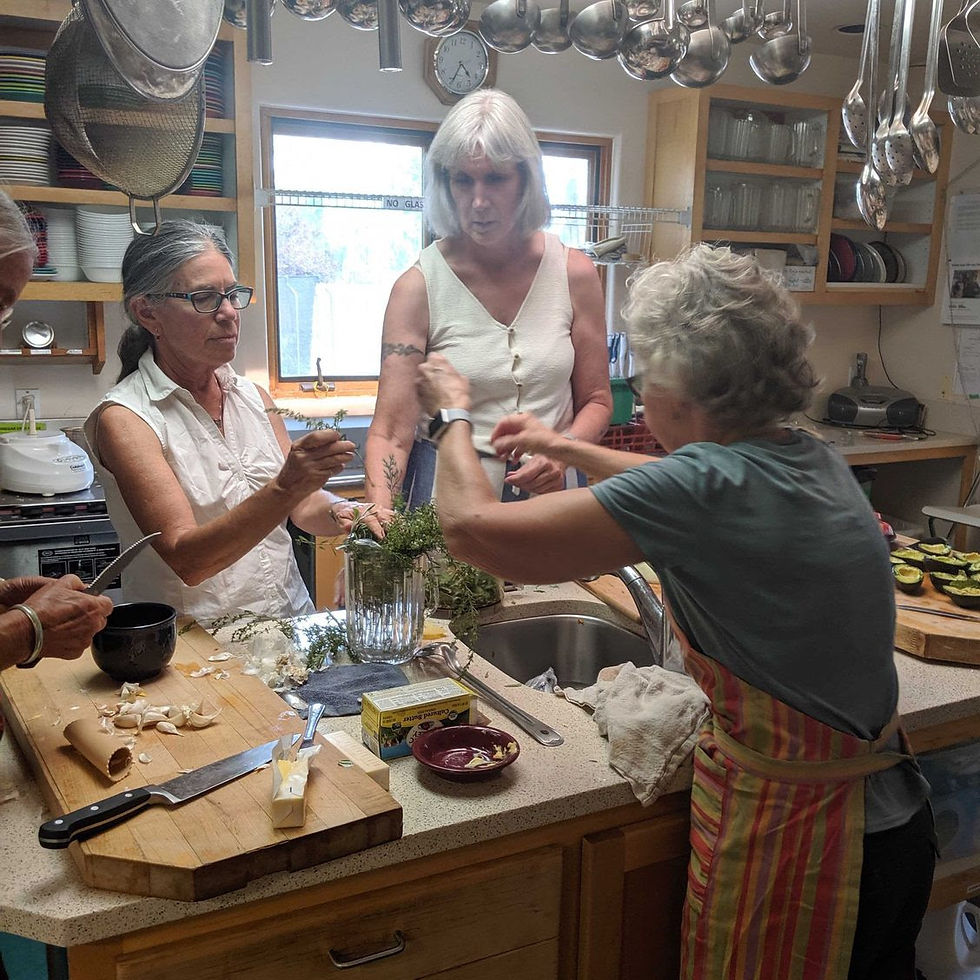Food Culture: A Reflection of Our Values
- cohousingabq
- Dec 27, 2023
- 3 min read

Food culture often reflects our values. For Cohousing ABQ, values like mutual care and a small environmental footprint come high on the list.

That’s reflected in members’ shared food culture. From providing food in times of crisis, to teaching family recipes, to creating a colorful potluck from the talents of many cooks, the group already demonstrates its care for community members. Meanwhile, the group’s green thumbs are creating a shared garden space in line with our emphasis on low impact living. Here are just a few of the ways that our food culture gives a glimpse of who we are.
Care during crisis
Over the last few months, crises like a child in the hospital or a mobility-limiting injury saw immediate response from members. Friends organized to bring food before families had time to worry about next steps.
“Our cohousing community stepped in to feed us, so we had one less thing to worry about while we were [in the hospital],” Jessie says. “Our two-year-old was hospitalized this winter with common viruses. [During our stay], we received pasta dishes, green chile stew, asian noodle salad, and takeout from our favorite poke place, to name a few.”
From Jessie’s perspective, this is nothing new. “We were so grateful, but not surprised. When this same kiddo was born, I don’t think we cooked a meal for six weeks! Cohousing friends, many of whom we had never met due to COVID, kept us in good supply until we were on our feet.”
When Patti broke her hand earlier this spring, her experience was much the same. “The outpouring was generous and quick–from folks who don’t live in Albuquerque offering to order food. . . to folks coming over and cooking for an army. It was humbling. . . I had such a deep sense of community from the simple challenge of a broken wrist.”
Enjoying food traditions
The cohousing community has stepped up from the beginning with potlucks, too. Marlies, our project manager, raves, “we have some of the best cooks in our group and people use fresh ingredients to make meals [that] I might not have time to prepare myself.” The sheer diversity of dishes always means that no one ends up hungry for lack of something that fits their dietary needs.
And with members who have come from all over the United States and beyond, there are always opportunities to learn a new cuisine. For a recent salon, Setso led a cooking course on making Bulgarian kyopolo, teaching members how to transform eggplant into a delectable dip.


Beyond the food traditions brought from elsewhere, of course, are those that developed in New Mexico. Local farming enriches the options with the abundance of fresh onions, dried or roasted chiles, and savory local squash varieties. New Mexican indigenous peoples have developed and maintained local crop varieties like the Taos Pueblo Hubbard squash for hundreds and even thousands of years. As for chiles, New Mexico State University’s Dr. Fabián García started work more than a century ago on further developing and refining the already great diversity of chile in the region. New Mexico’s cuisine continues to thrive and change in part because of the continued innovation of farmers, researchers, and communities. Being able to participate in the continuation of such rich food and agriculture traditions means that New Mexican residents enjoy a particularly rich and varied culinary life.

Reaping a harvest
Cohousing ABQ members are carrying forward these traditions of shared food production and innovation even before construction begins. Alexej initiated a community garden in his family’s front yard and members and friends joined together to amend and plant the garden this year. With hundreds of tomato plants and a plan to share both work and produce, everyone involved is looking forward to the garden’s bounty. “The experience of warm tomatoes eaten fresh off the vine in the summer cannot be replaced with anything else,” says Marlies.
And it is not only our own members who already form part of the community of cohousing ABQ, but neighbors in the broader community. Katie and Josh’s farm already forms another important hub for members, who relish the weekly produce they offer. “Their greens last longer than any others, even from my own garden,” says Patti, “I will pull them out and two weeks later they still look freshly harvested!”

Shopping local
Vegetables found in deep, colorful piles at El Super, the nearest grocery store to the cohousing land, remind shoppers of the abundant agricultural tradition of the Rio Grande region. The store will represent an important nearby grocery store for cohousing ABQ as we cook our flavorful shared meals.
From the Downtown Growers’ Market, to La Montanita co-op, to abundant community-supported agriculture options, members of cohousing ABQ are spoiled for choice.
Moving in
Cohousing ABQ is pushing to move rapidly toward construction, but it’s clear that the community already exists–buildings or no. And the ways in which neighbors already share their talents, time, and traditions bodes well for how shared meals and kindness will grow.







Comments